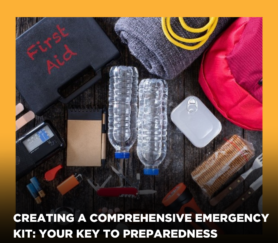National Preparedness Month Vol. 2: Creating a Comprehensive Emergency Kit: Your Key to Preparedness
- By: National Network of Public Health Institutes and Jennifer Ventura
- Date
In a world where unforeseen circumstances can disrupt our daily lives, having a comprehensive emergency kit is a vital step toward being prepared for any eventuality. Whether it’s a natural disaster, power outage, or an unforeseen crisis, having essential supplies on hand can make a huge difference in making it easier to manage. The Federal Emergency Management Agency (FEMA) has highlighted these items below. As we observe Environmental Preparedness Month this September, let’s dive into the crucial task of creating a well-equipped emergency kit.
The Essentials of an Emergency Kit
An emergency kit should contain essential items that can sustain you and your family for a minimum of three days. This kit serves as your lifeline during times when basic services might be unavailable. Here’s what a comprehensive emergency kit should include:
- Water and Non-Perishable Food: Stock up on water, aiming for at least one gallon per person per day. Pack non-perishable food items like canned goods, energy bars, and dried fruits to sustain you and your loved ones without the need for refrigeration.
- First Aid Supplies: A well-stocked first aid kit should include bandages, antiseptic wipes, tweezers, adhesive tape, pain relievers, and any necessary prescription medications.
- Light and Communication: Include a flashlight with extra batteries, a battery-powered or hand-crank radio, and a whistle to signal for help.
- Clothing and Bedding: Pack sturdy shoes, warm clothing, and blankets to keep you comfortable in varying weather conditions.
- Personal Documents: Keep important documents like identification, insurance policies, medical records, and financial information in a waterproof container.
- Sanitation and Hygiene: Include items like moist towels, hand sanitizer, toilet paper, and personal hygiene products.
- Tools and Supplies: A multi-tool, duct tape, and a manual can opener could aid in various situations.
- Cash: Having a small amount of cash on hand can be essential as during many environmental disasters electronic payment methods become unavailable.
Customizing Your Kit
Every individual or family has unique needs. Consider factors like the number of family members, pets, and any specific medical or dietary requirements. Tailor your emergency kit to accommodate these needs, ensuring that every member of your household is taken care of during an urgent time.
Maintaining and Updating Your Kit
Creating an emergency kit is just the beginning. Regularly check and update the contents to ensure that items are in good condition and within their expiration dates. It’s important to be sure to rotate perishable items and update documents as necessary.
As we celebrate Environmental Preparedness Month, take the opportunity to assemble and/or review your emergency kit. Remember that preparedness is a continuous effort that everyone should take part in, and an up-to-date kit can be your lifeline during challenging times. By taking proactive steps today, you’re ensuring a safer and more resilient tomorrow.
About the Author:
Jennifer Ventura is a Program Assistant on the Climate, Crisis, and Preparedness Portfolio at the National Network of Public Health Institutes (NNPHI). She received her bachelor’s degree in Public Health from George Mason University in 2021. With an interest in Public Health and working on a focus on environmental health, my passion lies in understanding the relationship between human well-being and the environment. Through academic pursuits and current work experiences, I’ve become interested in the critical role of promoting climate change awareness. Recognizing that a healthy environment is crucial for community health, I’m dedicated to advocating for policies and practices that foster sustainability and safeguard the planet for current and future generations.


 Subscribe To Our Communications
Subscribe To Our Communications